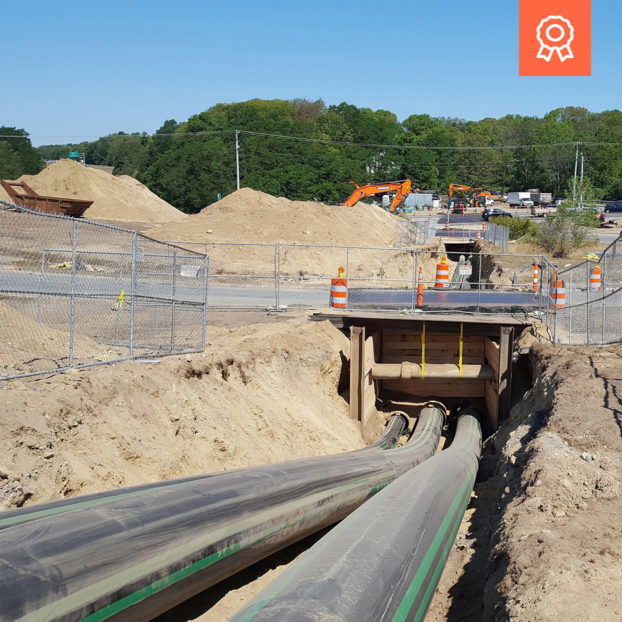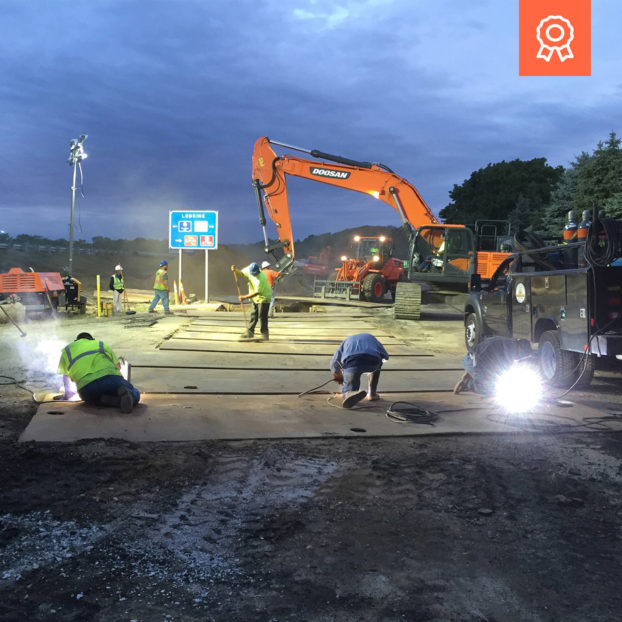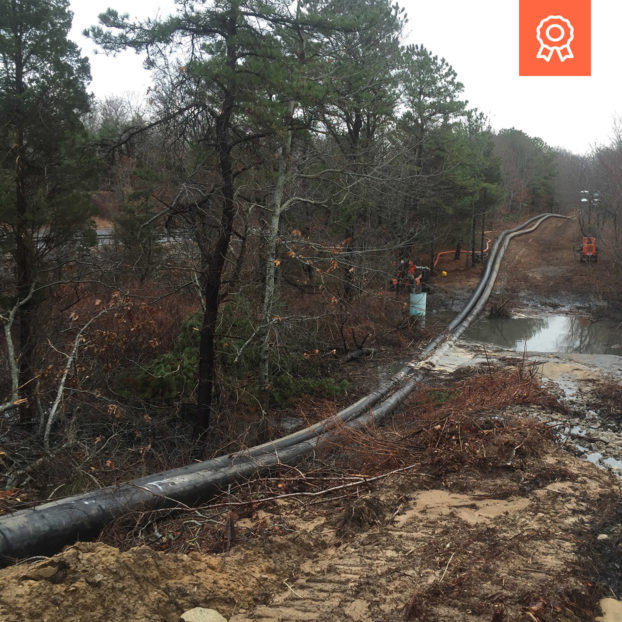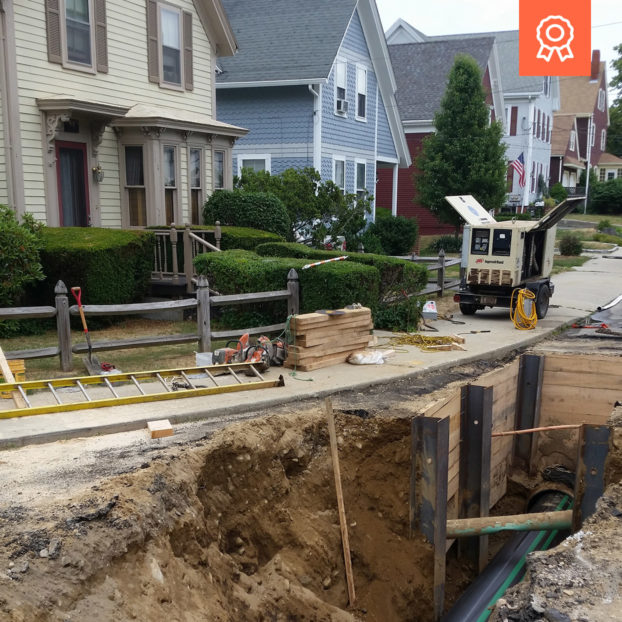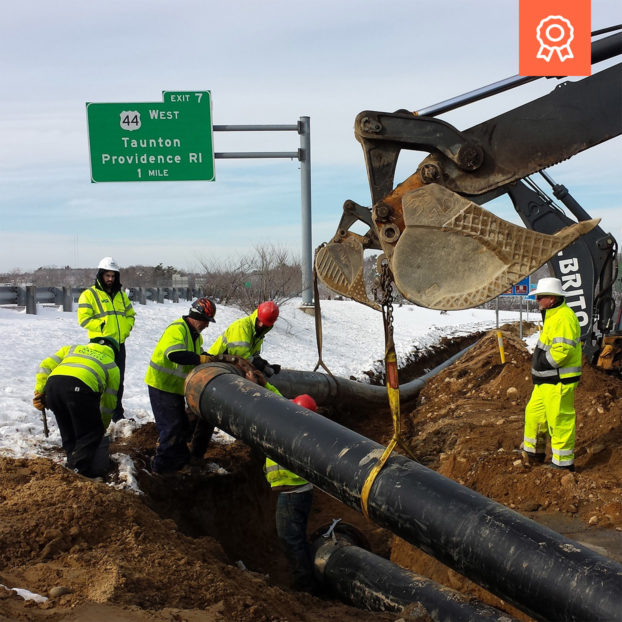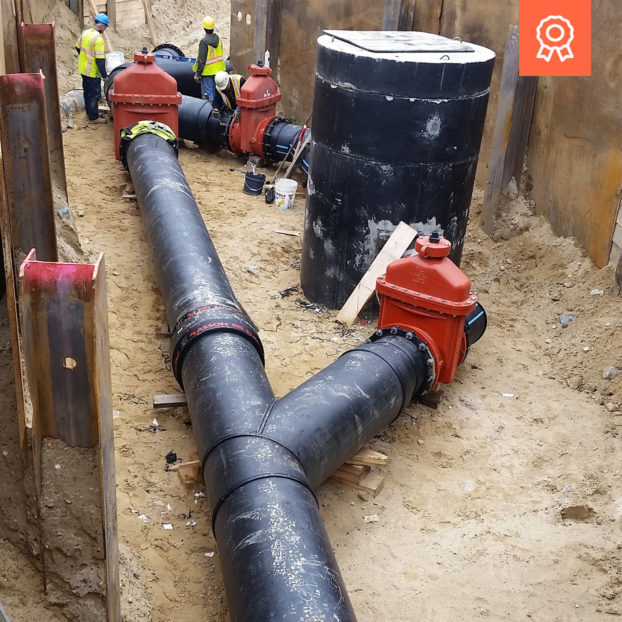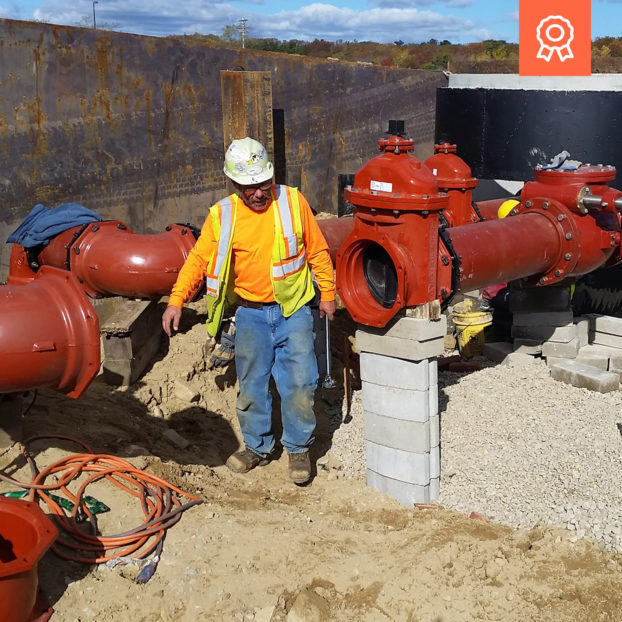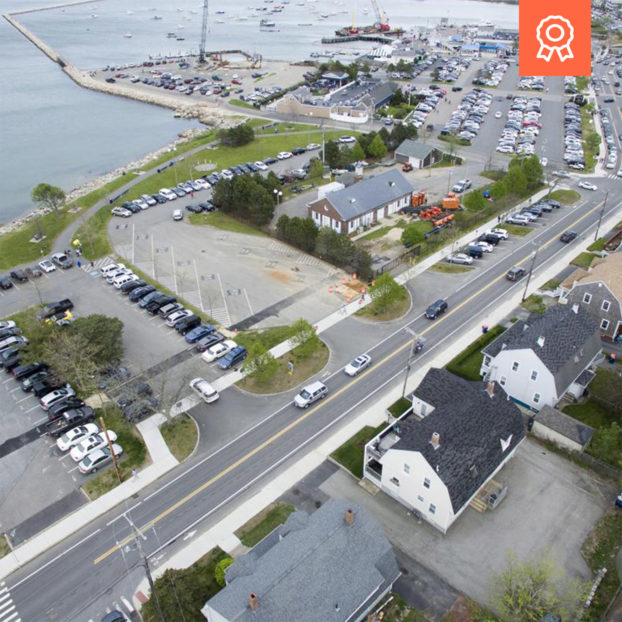On a cold Saturday in December 2015, the Town of Plymouth, MA experienced a catastrophic rupture of a 30-inch, cement lined ductile iron wastewater force main that carried the Town’s entire sewage flow from the Water Street Pump Station (WSPS) to the Plymouth Wastewater Treatment Facility (PWTF). With no redundant force main, 1.5 MGD of wastewater was flowing across the ground surface along the force main right-of-way.
The Town called in an emergency contractor to respond to the break, and Environmental Partners to monitor the work and provide design/consulting services as needed to assess the causes, and evaluate and execute solutions. Within 45 days, the Town faced three unexpected and catastrophic sewer main ruptures, each causing unique impact concerns despite requiring similar responses, which Environmental Partners managed alongside ongoing emergency services.
Force Main Rupture 1
The first break, occurring on December 19, 2015, roughly one mile from the Plymouth Waste Treatment Facility caused a pond of raw sewage to collect within the easement parallel to State Highway Route 3, the primary north-south highway from Boston to Cape Cod, and property of the Massachusetts Department of Transportation. Within hours of discovery, the decision was made to engage a fleet of up to 15 septic pump trucks to continuously transport sewage from the pump station to the treatment plant around the clock while Town officials further assessed the crisis and selected the best course of action. By 5 am the following morning, officials had made the decision to run a temporary bypass between the rupture site and the PWTF, fusing 40’ sections of bypass pipe at a time with construction crews working 24 hours a day. On December 24, just 4 days after the initial rupture, operators were able to begin pumping flow through the bypass pipes.
The Department of Public Works then began working with EP to conduct a forensics evaluation of the force main and decide upon the best course of action for repair. As part of the forensic review, EP constructed a complete hydraulic model of the force main, which indicated as many as three additional locations along the 4.5-mile pipe that could be in danger of corrosion-induced failures. Test pits were being dug along the entire pipeline, and a contractor had been brought in to clean out sludge and debris from the last mile of the force main.
Force Main Rupture 2
In line with EP’s completed hydraulic model and the additional areas of concern, but sooner than expected, on January 27, 2016 a second failure occurred. This second break was more complex than the first due to its proximity to residences, a residential well, and a municipal drinking water well. The municipal well was shut down for several days over contamination concerns while EP and Town Engineering and Water Department staff determined that the wastewater flow would not migrate to the well. The mile-long bypass of this second ruptured section entailed multiple residential driveway crossings, and several road crossings. The effort required constant daily communications with MassDOT, state and local environmental officials, and local and state police for traffic management and safety. Crews were sent home after working nonstop for four days and managing to get the second bypass, another 10,000 feet of twin HDPE pipes, online by early morning January 31, 2016.
Force Main Rupture 3
Less than 24 hours after the second bypass section was put online, the unthinkable happened. Another rupture occurred about a mile away from the WSPS on January 31, 2016. This rupture threatened the transportation gateway to historic Downtown Plymouth and Plymouth Harbor. The most difficult piece of work occurred at the WSPS where an entirely new array of temporary pumps and controls to match the bypass lines was constructed outside of the pump station, which was fully shut down in order to access, clean, and assess the original force main. A triple array of 150 HP high pressure pumps with VFD units, manifolds, knife valves, and a 200 HP standby diesel pump was assembled and placed online on March 7.
After three sewer main breaks within a short 45 days in the harsh New England winter, and with the third bypass line up and running, the Town made the proactive decision to bypass the entire length of the 4.5 mile force main for fear of continued and repeated ruptures.
Permanent Solutions
With all three bypass sections online, the Town and EP shifted focus to finding a sustainable and permanent solution. While the bypass construction was proceeding, EP had been assessing alternative repair and replacement options for the Town. On March 8, the Department of Public Works and EP presented five design options along with cost estimates to the Board of Selectmen and interested residents. The Selectmen voted to support the recommended option which included slip lining 12,000 lf of the existing 30-inch line with a 24-inch HDPE pipe, abandoning or replacing 12,000 lf of the existing 30-inch main, and installing a 24-inch HDPE pipe by open cut excavation, installing a new 24” redundant pipe parallel to the first pipe, upgrading and rehabilitating the WSPS, and removing the 50,000 lf of temporary bypass pipe and the temporary “outside pump station”. Though this was the most expensive option, it was ultimately the most holistic. The Selectmen, with the support of EP, presented six repair options in the April 2016 Town Meeting and the Town unanimously passed the recommended hybrid slipline/replacement option with a redundant pipe at a price of $48.5 million.
Over the following three years, EP completed permitting, design, and construction phase services for Plymouth’s new 24-inch sewer force main repair by a slipline method using the existing 30-inch DI force main as a host pipe where feasible, and adding another 5 mile long 24-inch plastic pipe as a redundant pipe by open cut. Additionally, EP was engaged in the design to rehabilitate the Town’s WSPS, which is the primary pump station and headworks facility for the wastewater system. Those upgrades included replacement of process mechanical equipment such as pumps, bar screen, grit removal system, odor control, and associated gates, valves, and piping. Electrical and instrumentation systems were replaced and upgraded as associated with the process mechanical improvements. As the Town’s primary consultant, EP continued to interface with the State, contractors, the private operator of the wastewater system, the contractor’s engineering consultant, and the general public. Repair and replacement of the primary pipeline began in June 2016, and the pipeline was fully commissioned in January 2017.

